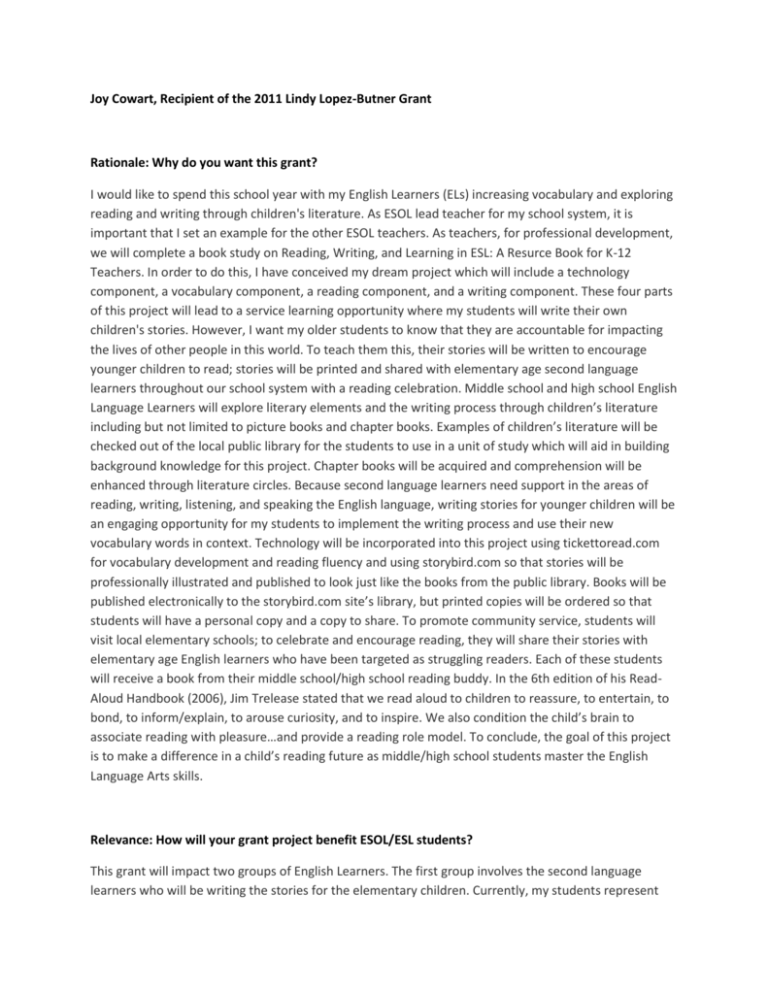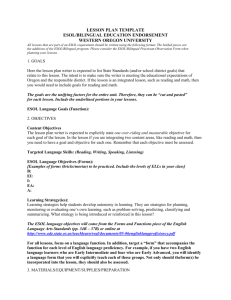Joy Cowart 2011 LopezButner Grant
advertisement

Joy Cowart, Recipient of the 2011 Lindy Lopez-Butner Grant Rationale: Why do you want this grant? I would like to spend this school year with my English Learners (ELs) increasing vocabulary and exploring reading and writing through children's literature. As ESOL lead teacher for my school system, it is important that I set an example for the other ESOL teachers. As teachers, for professional development, we will complete a book study on Reading, Writing, and Learning in ESL: A Resurce Book for K-12 Teachers. In order to do this, I have conceived my dream project which will include a technology component, a vocabulary component, a reading component, and a writing component. These four parts of this project will lead to a service learning opportunity where my students will write their own children's stories. However, I want my older students to know that they are accountable for impacting the lives of other people in this world. To teach them this, their stories will be written to encourage younger children to read; stories will be printed and shared with elementary age second language learners throughout our school system with a reading celebration. Middle school and high school English Language Learners will explore literary elements and the writing process through children’s literature including but not limited to picture books and chapter books. Examples of children’s literature will be checked out of the local public library for the students to use in a unit of study which will aid in building background knowledge for this project. Chapter books will be acquired and comprehension will be enhanced through literature circles. Because second language learners need support in the areas of reading, writing, listening, and speaking the English language, writing stories for younger children will be an engaging opportunity for my students to implement the writing process and use their new vocabulary words in context. Technology will be incorporated into this project using tickettoread.com for vocabulary development and reading fluency and using storybird.com so that stories will be professionally illustrated and published to look just like the books from the public library. Books will be published electronically to the storybird.com site’s library, but printed copies will be ordered so that students will have a personal copy and a copy to share. To promote community service, students will visit local elementary schools; to celebrate and encourage reading, they will share their stories with elementary age English learners who have been targeted as struggling readers. Each of these students will receive a book from their middle school/high school reading buddy. In the 6th edition of his ReadAloud Handbook (2006), Jim Trelease stated that we read aloud to children to reassure, to entertain, to bond, to inform/explain, to arouse curiosity, and to inspire. We also condition the child’s brain to associate reading with pleasure…and provide a reading role model. To conclude, the goal of this project is to make a difference in a child’s reading future as middle/high school students master the English Language Arts skills. Relevance: How will your grant project benefit ESOL/ESL students? This grant will impact two groups of English Learners. The first group involves the second language learners who will be writing the stories for the elementary children. Currently, my students represent about 10 different countries, and many are American born. Most of my students receive free lunch. Because these students use another language at home, they need immense support with English. Due to their poor living conditions, books in the home are limited, and they were never taught the love of books or the value of reading aloud to children. Children’s literature is a great way to help them understand the pattern of our language, see sentence structures, learn new vocabulary words, and identify literary elements which are all part of the Georgia Performance Standards. It is my goal that my students will take what they learn and visit the public library with their younger siblings to check out books, and hopefully, read aloud in English to the smaller children in the home. The second group of children who will be impacted by this project will be from local elementary schools. They are the students who will be read to and who will receive a copy of the book. My English Learners need nonthreatening learning experiences that come alive for them. Using fiction and nonfiction children's literature in the classroom allows me to afford them with learning opportunities in English. Not only will the students read children's books, but they will be read to by their ESOL teacher who believes that a love for reading leads to a love for writing. We can learn new vocabulary words. We can focus on sentence structure. We can build on the parts of speech. We can identify literary elements including but not limited to figurative language, character, setting, plot, and so forth. Through modeled writing, we can change the endings of stories, analyze character traits, or respond to literature through well developed paragraphs and essays. Imagine the English language coming alive through children's literature as WIDA's English Language Development standards are weaved into these lessons. This grant will allow students to use technology. Many of my students do not have access to computers once they leave the classroom. However, they are still "tech-savvy" students, and they love opportunities to engage in learning with technology as a tool. That is why I have written in the use of tickettoread.com as part of this grant. I did a trial run with it this past summer in a week long summer school, and the students were exposed to so many new vocabulary words as they read the fiction and nonfiction selections. This program was able to take them places and expose them to information on their individual learning levels. The use of storybird.com will make the students think on a higher level as they must pick out the illustrations for their stories prior to writing their children's stories. This will be a challenge. It will take some time, but the end products will be worth it. Objectives: Who is your target population? How will this grant help to meet the standards and expectations of your program? My target population includes the second language learners in my ESOL middle school and high school classrooms. English Language Development standards for this grant will be as follows: English language learners will communicate for Social and Instructional purposes within the school setting. English language learners will communicate information, ideas, and concepts necessary for academic success in the content area of Language Arts. Georgia Performance Standards for this project will be as follows: 1. The student demonstrates comprehension of various literary elements by using them in an original writing sample including but not limited to the following: examples of diction, imagery, point of view, figurative language, symbolism, plot events, character, setting, sensory imagery, allusion, irony, etc. 2. The student understands and acquires new vocabulary and uses it correctly in reading and writing. 3. The student produces writing that establishes an appropriate organizational structure, sets a context and engages the reader, maintains a coherent focus throughout, and signals closure. 4. The student demonstrates understanding and control of the rules of the English language, realizing that usage involves the appropriate application of conventions and grammar in both written and spoken formats. 5. The student participates in student-to-teacher, student-to-student, and group verbal interactions. 6. The student uses the writing process to produce and publish children’s literature. Last but not least, my English learners will be involved in a community service project. They will realize the impact that they can make on the younger children around them as they reach out to them and encourage them. Implementation Plan: How will you go about using this grant project in your classroom? ESOL teachers within our system will participate in a book study on reading and writing in the ESL classroom. As a result, I will complete a project. Through my actions, I hope to encourage the other teachers in the system to make learning memories with their students. The following is my classroom implementation plan: 1. Daily, students will be exposed to literary elements, grammar practice, new vocabulary, and reading samples. Weekly, students will use tickettoread.com for vocabulary development, exposure to fiction and nonfiction reading samples, and reading fluency practice. 2. Children's literature will be acquired from the local public library via a community partnership. Students will spend time involved in analyzing children’s literature through books acquired from the local public library and through chapter books which will be used in literature circles. This will help them build background knowledge and understanding for their projects. This part of the grant will last a minimum of one semester. 3. Students will be exposed to prior stories written by students using storybird.com. 4. The teacher will model writing paragraphs, essays, and children's stories for the students. 5. Using the writing process (prewriting, drafting, revising, editing, and publishing), students will use storybird.com to write and illustrate their children’s stories. 6. A group of high school students in an advanced English class will collaborate and act as editors and offer final suggestions before the children’s books are published. 7. Once books are published, copies will be ordered from storybird.com. 8. A Reading Celebration field trip will be organized so that the second language learners can go to a local elementary and share their books with younger English Learners. Each of these children will receive their own special book. 9. High school students will be encouraged to log their time with the students on their community service forms, so that they may earn enough hours towards their goal of graduating with a community service medallion. 10. A rubric will be created to assess middle and high school students on their final products. Evaluation: How will you measure the success of this grant project? Student blogs will be used to qualitatively evaluate this project. Students will be encouraged to blog about this project and the experience of becoming an author. At the end of the school year, writing portfolios will be evaluated. Students should be able to see their growth in writing from the beginning of the year to the end of the year. The ACCESS Test for English Language Proficiency will be used for quantitative measures for this project. ACCESS reading and writing scores should increase as a result of this project. Reading and ELA CRCT scores should be impacted by this project. Georgia High School Graduation Test scores in the areas of ELA and writing should be positively impacted through this project. EOCT scores in Literature classes should be enhanced via this project. A picture is worth a thousand words. Photos of students at the reading celebration will be used to evaluate this project. Itemized Budget: Please provide details on how the grant money would be used and please also list any other grants or monies you may receive for this purpose. 6 Copies of Reading, Writing, and Learning in ESL: A Resource Book for K-12 Teachers 300.00 www.tickettoread.com licenses for 20 students 300.00 60 PDFs ordered from Storybird.com at 1.99 each plus .06 international charge fees 123.00 Printing and binding stories for students 100.00 Reading Celebration Snacks 62.00 Field Trip to Elementary School Bus Driver (Due to lack of system funds) 65.00 TOTAL 950.00 Sharing: How will you share your grant project with Georgia TESOL colleagues? Be as specific as possible and please note the requirements of the grant as listed in the grant description. 1. Present at a GATESOL conference. 2. Write an article for the GATESOL newsletter. 3. Share stories archived in the storybird library written by my ESOL students with ESOL teachers in my region. I will send them an invitation with a username and password so that ESOL students in neighboring counties will have the opportunity to enjoy my students' final products. 4. Write an article on the school's website about this project.







